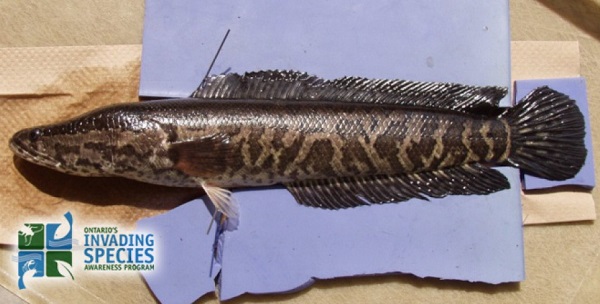
A Chatham man has been fined $2,000 for illegal possession of snakehead fish. Yung-Chieh Liu pleaded guilty to illegally possessing live invasive fish. In addition to the fine, two snakehead fish were also forfeited to the Crown.
Justice of the Peace Malcolm Rogers heard the case in the Ontario Court of Justice, Blenheim, on April 17, 2013.
The Ministry of Natural Resources reminds residents that it is against the law to have certain invasive species in your possession, because they pose a serious threat to native species and ecosystems.
“The Northern Snakehead might enjoy life in Canada, but it would not be welcome here. This fish, native to eastern Asia, has invaded parts of the United States, where it threatens to disrupt ecosystems and native fish species unaccustomed to its presence. Scientists at Fisheries and Oceans Canada (DFO) want to stop the snakehead from establishing a base in Canadian waters – and building a strong defence is the key to success.
The risk posed by snakeheads is very real. Several of the 36 species have a long history of invasions, and are very hardy. They can even live out of the water for a time – to pursue their prey or find a new home if the former one dries up. They survive winter under the ice of northern lakes; some have even recovered from being frozen! The Northern Snakehead, in particular, thrives on conditions that are similar to many Canadian waters. It is a voracious predator, and it grows rapidly to an adult length of 1.5 metres or more.
In their native waters, some snakehead species are fished for food or used for aquaculture. Many are exported to other countries where they may be sold live in food markets and pet shops. Scientists believe that the Northern Snakeheads found in lakes in some US cities may have originated from food markets. Some may have been released to the wild in an ill-advised attempt at fish stocking or because they were no longer wanted as pets.” Department of Fisheries and Oceans Canada

For further information about fishing regulations, please consult the 2013 Recreational Fishing Regulations Summary, available at ServiceOntario/Government Information Centres, licence issuers and at ontario.ca/fishing.
To report a natural resources violation, call 1-877-TIPS-MNR (847-7667) toll-free any time or contact your local ministry office during regular business hours. You can also call Crime Stoppers anonymously at 1-800-222-TIPS (8477).
UPDATE-
Hundreds of invasive species established in Ontario
Not all non-native species are invasive. Invasive species are defined as harmful alien species whose introduction or spread threatens the environment, the economy, or society, including human health. Once established, invasive species can be extremely difficult and costly to control and eradicate, and their ecological effects are often irreversible.
Invasive species certainly came to light in Ontario when sea lamprey took advantage of the Welland Canal to gain access to the Great Lakes in the early 1900s. Sea lamprey use a sucker-like mouth and sharp teeth to attach to a fish and suck the blood out of it. Only one in seven fish survive a lamprey attack and trout species are more vulnerable.
Zebra and quagga mussels were the next big invader affecting aquatic ecosystems. Arriving in ship ballast from Europe, these freshwater mussels quickly took over in the Great Lakes, then inland lakes, displacing native mussels. Their numbers were so huge a problem developed with them clogging municipal water intakes. The impact of these mussels started the movement to make society more aware of invasive species.
Many aquatic invasive species followed a similar pattern for becoming established. The Asian carp, which could be the greatest threat facing Ontario’s lakes and rivers, is an exception. The four sub-species of Asian carp were brought to the southern United States in the 1960s and escaped into the wild. Since then they have moved northward along the Mississippi River system.
In some cases, invasive plants spread were intentionally planted in people’s gardens, unaware of the potential of spreading. Purple loosestrife is one example of this. It’s also one of the invasive species eradication success stories. Periwinkle, English ivy and goutweed are also ornamental plants that have become established and invasive.
It’s my hope that phragmites can become the next invasive species control success story. This tall reed grabs hold in wetlands, ditches and any wet spot. It quickly spreads and crowds out native vegetation. This was evident in the marshes of Long Point Bay, where a control effort recently eliminated much of it. For landowners, the Long Point Phragmites Action Alliance has a program available to assist with removal of this invasive.
Garlic mustard is gaining notoriety as it grabs a foothold in woodlots and backyards across southern Ontario. Brought to North America from Europe as an edible herb, it spreads quickly when established.
There is a huge list of other invasive plants, both terrestrial and aquatic, that pose threats: common buckthorn, dog-strangling vine, giant hogweed, hydrilla, water soldier and many more.
Invasive plants aren’t the only threats to our forests. Asian long-horned beetles, emerald ash borer and Dutch elm disease have all brought destruction to our woodlands. Oak wilt, a fungal pathogen, is not yet in Ontario but could wreak havoc if it became established.
Another threat to the province’s forests are wild pigs. These non-native pigs dig in the forest disrupting plants growing on the forest floor.
The most important thing with any invasives is prevention – preventing a non-native plant or animal to establish itself in the province – and individuals can make a difference in this regard.
Toby Barrett MPP for Haldimand-Norfolk
Northern snakeheads are a popular food in their native range; they re said to be good eating, particularly in watercress soup, if a bit bony. They re fished commercially and raised in fish farms in Asia. They ve also been sold live in markets in the United States. The Crofton snakeheads were eventually traced to a Maryland man who d bought two of the fish in New York City for his sister to eat. When she demurred, he kept them in his aquarium and later released them. The U.S. Fish and Wildlife Service soon banned the importation and interstate transport of snakeheads, a plan that had already been in the works precisely because of fears that some snakehead species could thrive in parks, rivers and lakes if they got loose. The ban made it illegal to import all live snakehead species, including the colorful tropical species that populate the odd aquarium. Virginia has outlawed the possession of all snakeheads.